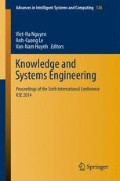Abstract
UML is the de facto standard for modelling concurrent systems in the industry. Activity diagrams allow designers to modelworkflows or business processes. Unfortunately, their informal semantics prevents the use of automated verification techniques. In this paper, we first propose activity diagram patterns for modelling timed concurrent systems; we then devise a modular mechanism to compose timed diagram fragments into a UML activity diagram that also allows for refinement, and we formalise the semantics of our patterns using time Petri nets.
Work partially supported by STIC Asie project “CATS (Compositional Analysis of Timed Systems)”.
Access this chapter
Tax calculation will be finalised at checkout
Purchases are for personal use only
Preview
Unable to display preview. Download preview PDF.
References
OMG unified modeling language. version 2.5 beta 2 (September 5, 2013), http://www.omg.org/spec/UML/2.5/Beta2/PDF/
André, É., Choppy, C., Reggio, G.: Activity diagrams patterns for modeling business processes. In: Lee, R. (ed.) SERA 2013. SCI, vol. 496, pp. 197–213. Springer, Heidelberg (2013)
Bernardi, S., Merseguer, J.: Performance evaluation of UML design with stochastic well-formed nets. Journal of Systems and Software 80(11), 1843–1865 (2007)
Berthomieu, B., Vernadat, F.: Time Petri nets analysis with TINA. In: QEST, pp. 123–124. IEEE Computer Society (2006)
Börger, E.: Modeling workflow patterns from first principles. In: Parent, C., Schewe, K.-D., Storey, V.C., Thalheim, B. (eds.) ER 2007. LNCS, vol. 4801, pp. 1–20. Springer, Heidelberg (2007)
Cook, W.R., Patwardhan, S., Misra, J.: Workflow patterns in orc. In: Ciancarini, P., Wiklicky, H. (eds.) COORDINATION 2006. LNCS, vol. 4038, pp. 82–96. Springer, Heidelberg (2006)
Distefano, S., Scarpa, M., Puliafito, A.: From UML to Petri nets: The PCM-based methodology. TOSEM 37(1), 65–79 (2011)
Grönniger, H., Reiß, D., Rumpe, B.: Towards a semantics of activity diagrams with semantic variation points. In: Petriu, D.C., Rouquette, N., Haugen, Ø. (eds.) MODELS 2010, Part I. LNCS, vol. 6394, pp. 331–345. Springer, Heidelberg (2010)
Jensen, K., Kristensen, L.M.: Coloured Petri Nets – Modelling and Validation of Concurrent Systems. Springer (2009)
Kordon, F., Thierry-Mieg, Y.: Experiences in model driven verification of behavior with UML. In: Choppy, C., Sokolsky, O. (eds.) Monterey Workshop 2008. LNCS, vol. 6028, pp. 181–200. Springer, Heidelberg (2010)
Lime, D., Roux, O.H., Seidner, C., Traonouez, L.-M.: Romeo: A parametric model-checker for petri nets with stopwatches. In: Kowalewski, S., Philippou, A. (eds.) TACAS 2009. LNCS, vol. 5505, pp. 54–57. Springer, Heidelberg (2009)
Mekki, A., Ghazel, M., Toguyeni, A.: Validating time-constrained systems using UML statecharts patterns and timed automata observers. In: VECoS, pp. 112–124. British Computer Society (2009)
Merlin, P.M.: A study of the recoverability of computing systems. PhD thesis University of California, Irvine, CA, USA (1974)
Workflow Patterns Initiative. Workflow patterns home page, http://www.workflowpatterns.com
Author information
Authors and Affiliations
Editor information
Editors and Affiliations
Rights and permissions
Copyright information
© 2015 Springer International Publishing Switzerland
About this paper
Cite this paper
André, É., Choppy, C., Noulamo, T. (2015). Modelling Timed Concurrent Systems Using Activity Diagram Patterns. In: Nguyen, VH., Le, AC., Huynh, VN. (eds) Knowledge and Systems Engineering. Advances in Intelligent Systems and Computing, vol 326. Springer, Cham. https://doi.org/10.1007/978-3-319-11680-8_27
Download citation
DOI: https://doi.org/10.1007/978-3-319-11680-8_27
Publisher Name: Springer, Cham
Print ISBN: 978-3-319-11679-2
Online ISBN: 978-3-319-11680-8
eBook Packages: EngineeringEngineering (R0)

